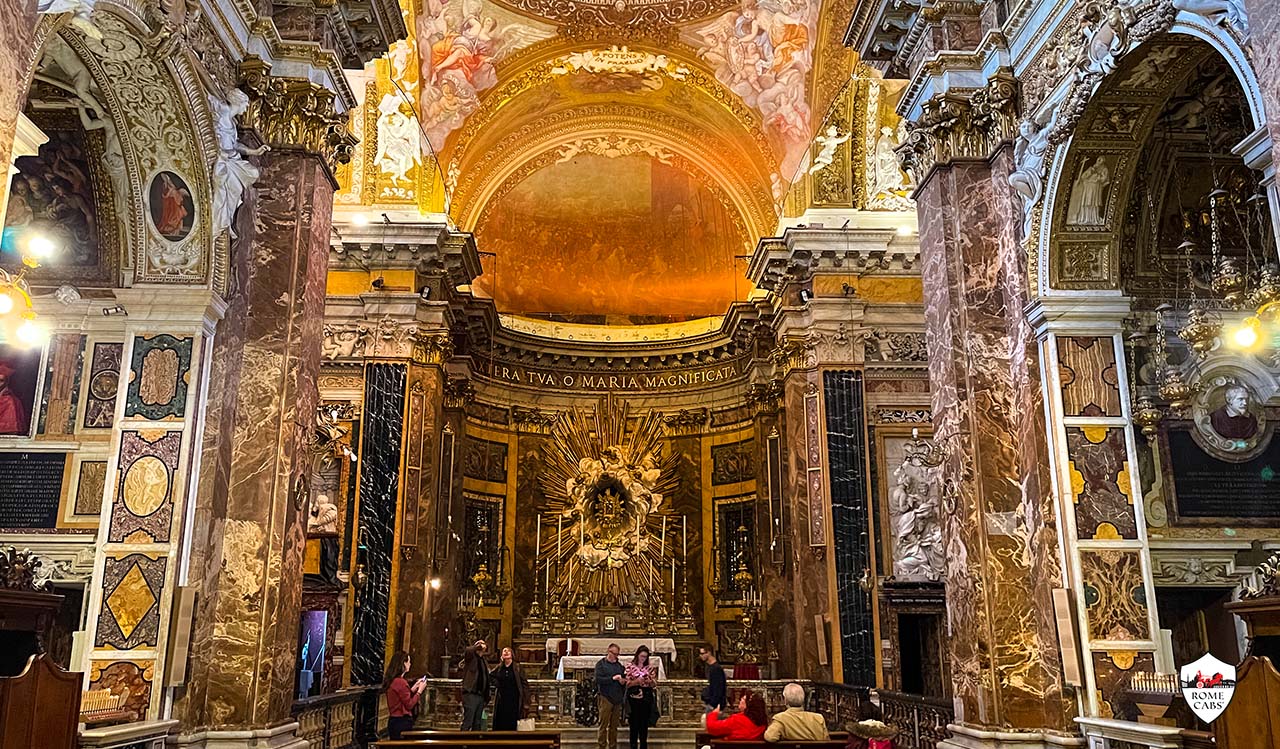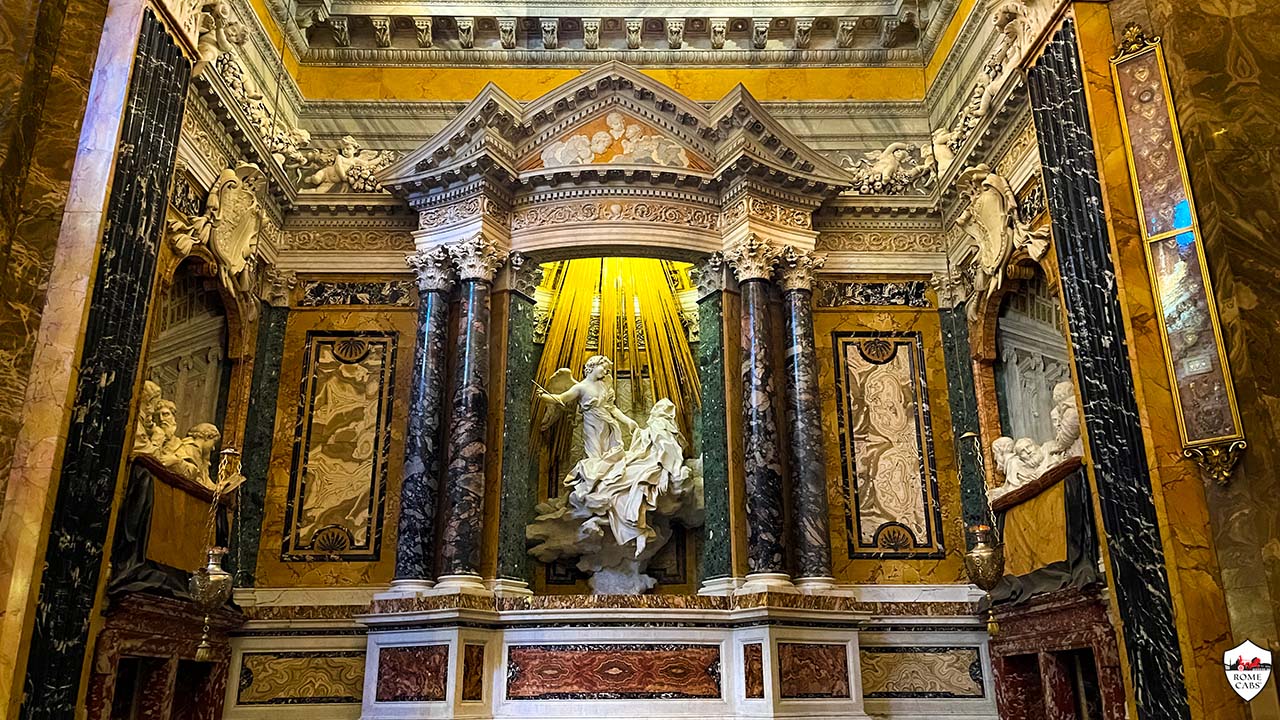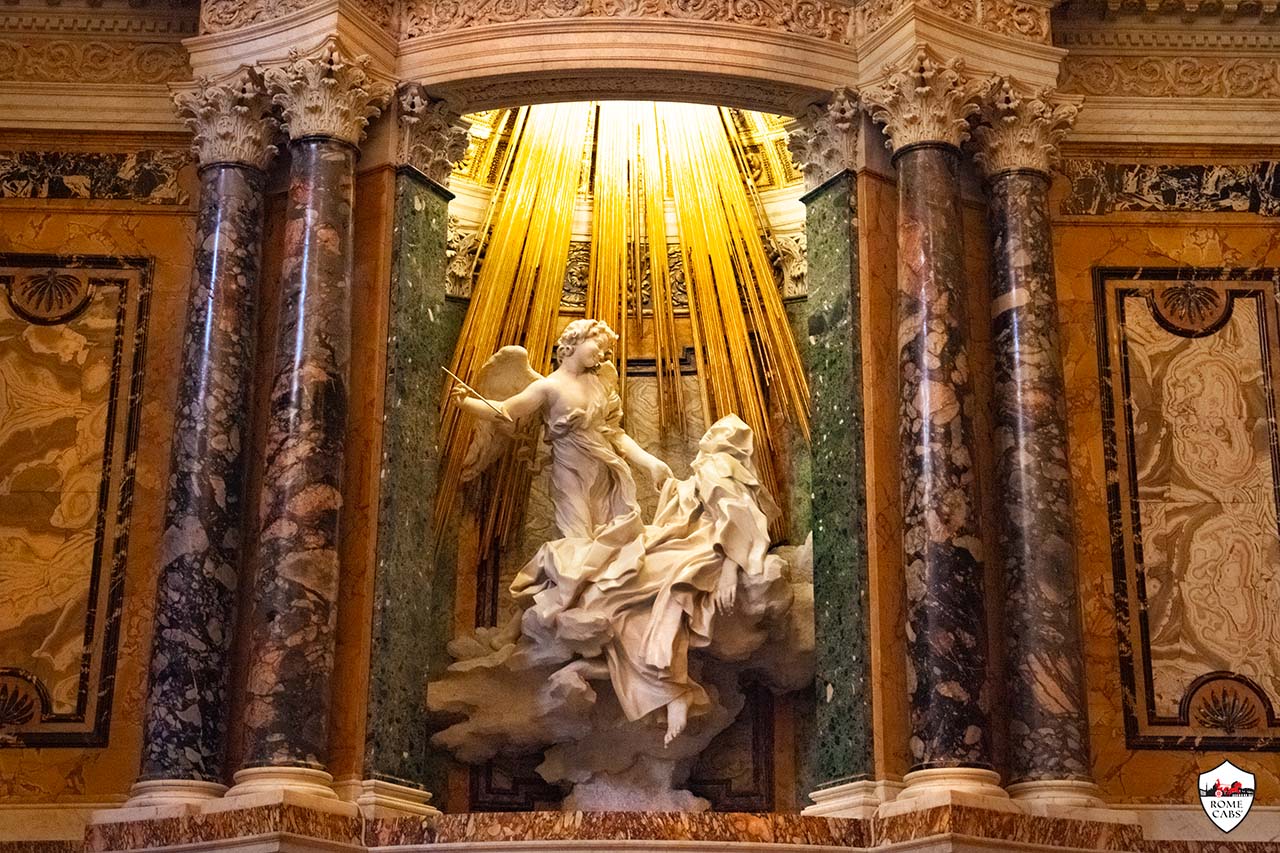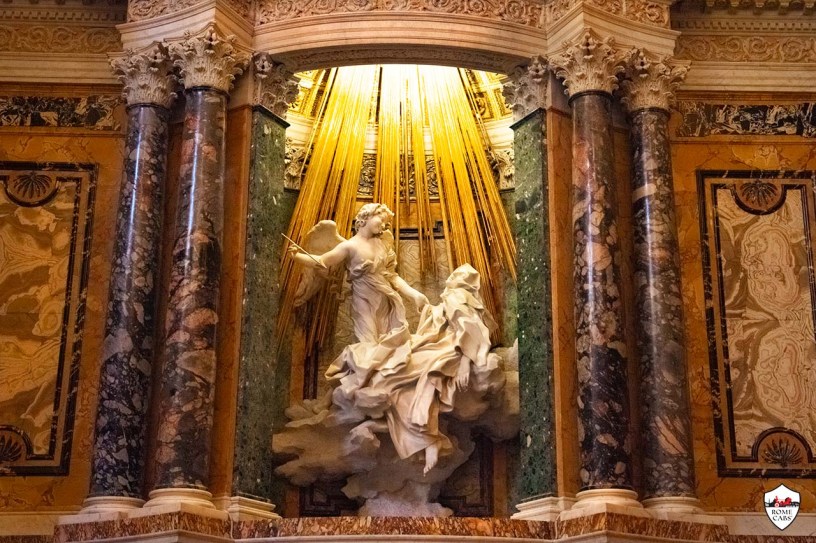.
Buongiorno and welcome to RomeCabs Italy travel blog! Located in a busy intersection in Rome on Via Venti Settembre next to Lago Santa Susanna, stands the remarkable Santa Maria della Vittoria, a Catholic titular church and basilica dedicated to the Virgin Mary.
This architectural gem is not only a testament to faith but also a showcase of the artistic prowess of the Baroque period. At its heart lies the Cornaro Chapel, home to Gian Lorenzo Bernini‘s masterpiece, the Ecstasy of Saint Teresa, a work that has stirred both admiration and controversy over the centuries. This tiny church was also featured in Dan Brown’s blockbuster “Angels and Demons”.
On your next Roman holiday, make sure you visit Santa Maria della Vittoria, and marvel at its baroque masterpiece.
.
A Triumph of Faith: History and Architecture
.
The origins of Santa Maria della Vittoria trace back to 1607 when the land for the church was purchased with the intention of building a chapel dedicated to Saint Paul for the Discalced Carmelites. However, after the Catholic victory at the Battle of White Mountain in 1620, the church was rededicated to the Virgin Mary, symbolizing the triumph of Catholicism over the Reformation.
The church’s history is further enriched by the presence of Turkish standards captured during the 1683 siege of Vienna, serving as tangible reminders of the Virgin Mary’s role in leading Catholic armies to victory.
The church’s exterior, the sole creation of Carlo Maderno, showcases the influence of the early Baroque style. The façade, completed by Giovanni Battista Soria, harmoniously blends with the nearby Church of Santa Susanna. Despite a fire in 1833 that necessitated interior restoration, the church has retained its grandeur and spiritual significance.
.
An Interior of Elegance and Devotion
.
Stepping into Santa Maria della Vittoria reveals a single wide nave under a low segmental vault, adorned with three interconnecting side chapels. Colossal Corinthian pilasters with gilded capitals support an enriched entablature, and contrasting marble revetments feature white and gilded stucco angels and putti in full relief. The interior, enriched over time, boasts frescoes by Giovanni Domenico Cerrini, illustrating triumphant themes within shaped compartments.
The church houses an array of sculptural masterpieces, including The Dream of Joseph by Domenico Guidi and the funeral monument to Cardinal Berlinghiero Gessi. Paintings by renowned artists such as Guercino, Nicolas Lorrain, and Domenichino further contribute to the church’s aesthetic splendor. Additionally, Santa Maria della Vittoria serves as the final resting place of Saint Victoria, whose preserved remains are on display within.
.

.
The Cornaro Chapel: A Controversial Masterpiece
.
The Cornaro Chapel within Santa Maria della Vittoria is a sanctuary of art and controversy, where Gian Lorenzo Bernini’s “Ecstasy of Saint Teresa” reigns as a masterful and provocative depiction of divine transcendence. To truly appreciate the controversy surrounding this remarkable sculpture, it is essential to delve into both the historical context and the artistic innovations that define this iconic piece.
.
Historical Context: The Life of Saint Teresa of Avila
Saint Teresa of Avila, a Spanish mystic and writer, lived during the 16th century, a time of profound religious fervor. She played a significant role in the Catholic Counter-Reformation and was known for her mystical experiences and visions. In her autobiography, “The Life of Teresa of Jesus“, she vividly described an encounter with a Seraph, an angelic being, who pierced her heart with a golden shaft. This intense and transcendent moment serves as the inspiration for Bernini’s sculpture in the Cornaro Chapel.
.
Gian Lorenzo Bernini: The Ecstasy of Saint Teresa
.

.
Gian Lorenzo Bernini, a prominent figure in the Baroque movement, was commissioned to create the Cornaro Chapel’s centerpiece. Completed between 1647 and 1652, the Ecstasy of Saint Teresa stands as a testament to Bernini’s ability to evoke intense emotion and spirituality through sculpture.
The sculpture captures the very essence of Saint Teresa’s mystical encounter. Teresa is portrayed in a state of ecstasy, lying on a cloud with her eyes closed and mouth slightly agape. The angelic Seraph descends, poised to strike her with an arrow, symbolizing the divine union between the saint and God. The entire scene is marked by dynamic movement, with swirling drapery and a sense of weightlessness that adds to the ethereal nature of the moment.
.
The Controversy Unveiled: Eroticism and Criticism
While undoubtedly a masterpiece, the Ecstasy of Saint Teresa has not been immune to controversy. Critics, both contemporary and over the centuries, have raised concerns about the perceived eroticism in Bernini’s portrayal of the saint. The sculpture depicts Teresa in a vulnerable and seemingly sensual state, prompting questions about the appropriateness of such a representation of a religious figure.
.

.
Bernini’s choice to emphasize physicality and passion in the depiction of a saintly experience challenges traditional artistic norms. Teresa’s posture, with her legs splayed apart and her clothing disheveled, has led some to argue that the sculpture borders on the explicit. The controversy surrounding the Ecstasy of Saint Teresa adds a layer of complexity to the interpretation of the artwork, as viewers grapple with the intersection of religious devotion and artistic expression.
The debate over the appropriateness of Bernini’s portrayal of Saint Teresa continues to captivate art historians, theologians, and the general public alike. The enduring legacy of the Cornaro Chapel lies not only in its religious significance but also in the ongoing dialogue it sparks about the boundaries of artistic expression and the portrayal of spirituality.
As visitors stand in the presence of the Ecstasy of Saint Teresa, they are invited to contemplate the convergence of the divine and the sensual, challenging preconceptions and stirring emotions. The controversy surrounding this masterpiece ensures that the Cornaro Chapel remains a captivating destination for those seeking to explore the intricate relationship between art, faith, and the complexities of human nature.
.
DISCOVER MORE:
- The Illusionary Marvel: Sant’Ignazio Church’s Dome and Frescoes
- Beyond the Colosseum: Exploring Rome’s Hidden Architectural Gems
- Piazza Navona in Rome: The Remarkable Story of its Unique Shape
- Why are the Spanish Steps so Famous?
.
Santa Maria della Vittoria stands as a testament to the intertwining of faith and art in the heart of Rome. Its rich history, stunning architecture, and controversial masterpiece ensure that this basilica remains a captivating destination for pilgrims, art enthusiasts, and historians alike.
Visitors are transported to a time when Baroque brilliance and religious devotion converged to create a lasting legacy. Browse through our Rome Limousine Tours and discover more wonders of Rome!
* Find us online also on:
